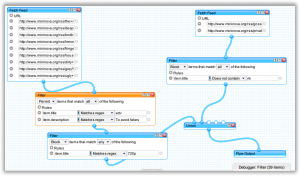The response of The Grey Album and 1+1+1+1=1
First I was so confused about Mashups. I was not sure I caught the point of its real meaning. When I finished reading The Grey Album Producer Danger Mouse Explains How He Did It and 1+1+1+1=1, I got an intuitionistic cognition of it.
These two articles are using music production as examples. They are both explaining the original meaning of Mushups: describing songs that mashed two different styles of music into one song.
For me, to get easier to understand what Mashup is, I would say it is a kind of remixing and rebuilding. But you do not need to ruin the original stuff; you should use them in your own way, deconstruct it. Here, many people may argue that Mashup in music producing seems to be kinda stealing. So back to these two articles, The Grey Album Producer Danger Mouse Explains How He Did It and 1+1+1+1+1=1, generally, they mentioned the published copyright. Simply, just considering about the commercial competition of Mashup music album production, it can act as a big role to balance the value of the New Album —- the Mashup Album. It is incontestable to say Mashup brings many benefits to support and prove the existence of it self. Actually, Mashup is fresh, but not the freshest thing, it has been here for some years. I have to say it is still improving. Obviously, if Mashup is simply remix two songs together, it might be died out. However, it has expanded to other field like the Web application. (Talked in another article.)
For The Grey Album Producer Danger Mouse Explains How He Did it, this article was talking about the specific steps of processing The Black and The White together. It is talked more about technique. Although, occasionally compelling, “The Grey Album” is not a great example of a Mashup, because the musical bed is processed so radically that its source is sometimes not clear. 1+1+1+1=1 was more focusing on marketing and the effects of entertainment.
Mashups find new uses for current digital technology, a new iteration of the cause-and-effect relationship behind almost every change in pop-music aesthetics: the gear changes, and then the music does.
Additionally, these two articles both mentioned the circumstance of processing a Mashup: Burton’s so-called studio was simple and crude. Since Mark Vidler, known professionally as Go Home Productions, explained some other benefits of digital technology to me in London not long ago: “You don’t need a distributor, because your distribution is the Internet. You don’t need a record label, because it’s your bedroom, and you don’t need a recording studio, because that’s your computer. You do it all yourself.” Mashup seems to be a real Go Home Production. You may build your own Soho with a low cost. Nevertheless, personally, I may concern the cost of absolutely necessary software: Acid Pro, an alternative to Pro Tools that retails for about $400. I do awfully agree with “Armed with free time and the right software, people are rifling through the lesser songs of pop music and, in frustration, choosing to make some of them as good as the great ones.” But is does not mean I’d like to spend $400 in the remix software for a Mashup song.
Fortunately, Mashup also describes a Web application that combines multiple services into a single application. I also did the research of Yahoo! Pipes. Many people discussed online it is really useful and easy to get understand. I got a course of studying how to build your own Yahoo! Pipes. This is much popular and par for a person to get work with Mashup, not only the product, but also the new concept.


Comments!